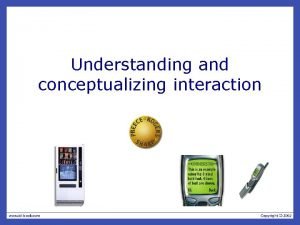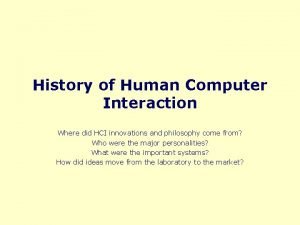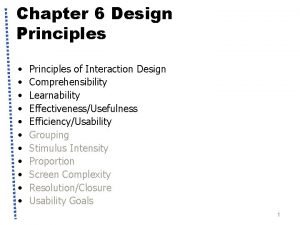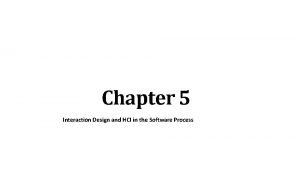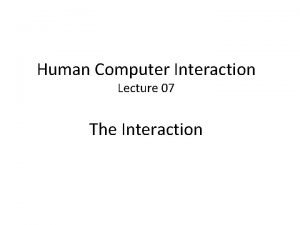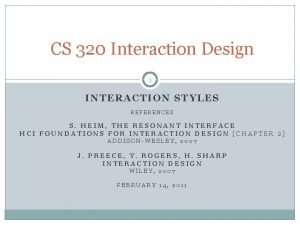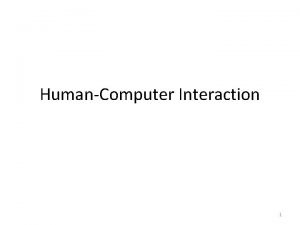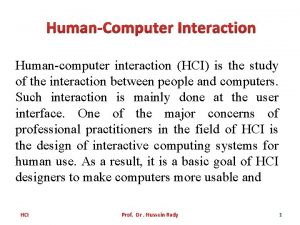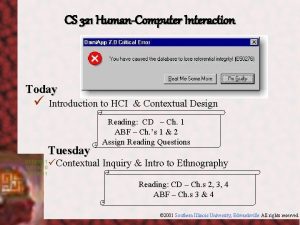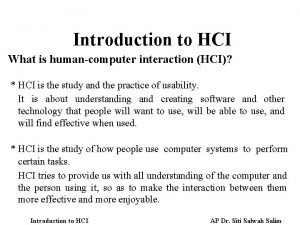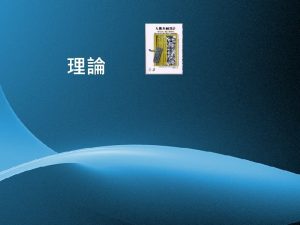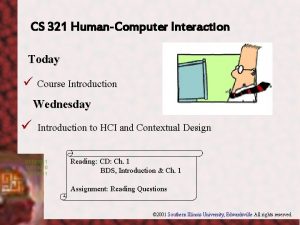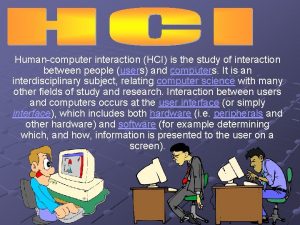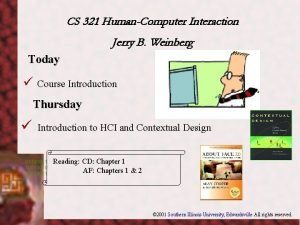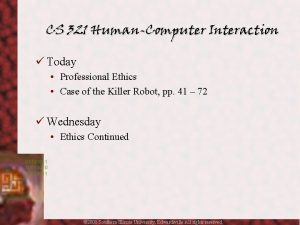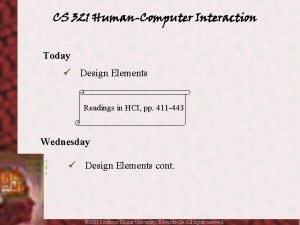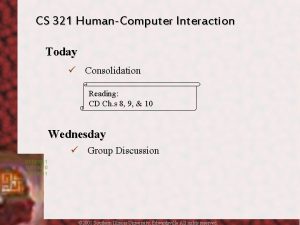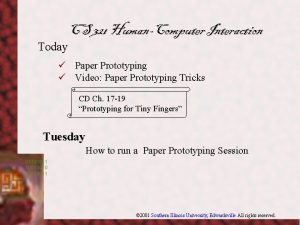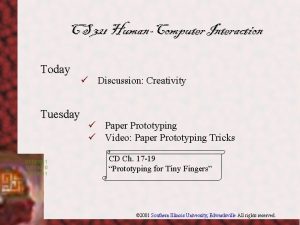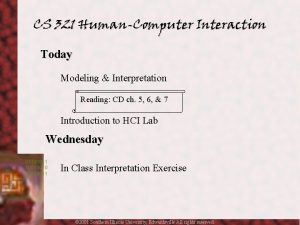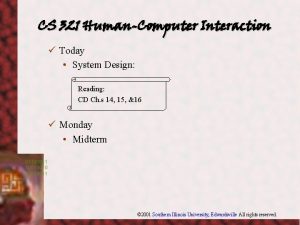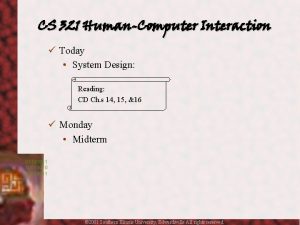CS 321 HumanComputer Interaction Today Introduction to HCI

















- Slides: 17

CS 321 Human-Computer Interaction Today ü Introduction to HCI & Contextual Design Reading: CD – Ch. 1 BDS – Intro & Ch. 1 Monday üContextual Inquiry & Intro to Ethnography Reading: CD – Ch. s 2, 3, 4 “Using Ethnography in Contextual Design” © 2001 Southern Illinois University, Edwardsville All rights reserved.

SMITH, JOHN E. 555326543 ü Why is it so difficult to create a schedule on Student Information System (SIS)? © 2001 Southern Illinois University, Edwardsville All rights reserved.

The System’s Work Model does not fit the User’s Work Model ü Any system forces a specific way for tasks to be done • System’s Work Model ü Every user has an understanding of how a task should be done • Conceptual Model, Mental Model ü For applications like the SIS the system’s model is hard to understand work with because it makes no sense in terms of the work being done. • Causes errors, non-use © 2001 Southern Illinois University, Edwardsville All rights reserved.

Example: How do people research a topic? © 2001 Southern Illinois University, Edwardsville All rights reserved.

What is Design? 1. Design is a creative activity of making artifacts that are usable for a specific purpose. ü Software Engineer • Software is reliable, robust, and maintainable ü Software Designer • Software fits the user’s overall activities, enhances productivity, and produces a satisfying experience (Enjoyable!) © 2001 Southern Illinois University, Edwardsville All rights reserved.

User’s Task Model vs. Engineer’s Model ü User’s task model A representation of the user’s conceptual model Linkages ü Engineer’s model Underlying implementation ü Main Goal: Make the Engineer’s model invisible to the user. © 2001 Southern Illinois University, Edwardsville All rights reserved.

From the Interface Hall of Shame The program, Woodworkers Estimate Helper provides a classical example of geekspeak. The program is “designed for woodworkers and cabinet makers”, and purports to assist in the process of calculating price quotes for their projects. Unfortunately the program uses such programming terminology as “Databases”, “Records”, and, if the user attempts to enter a duplicate part name, presents the message “Key Validation Error”. While we do not mean to disparage any woodworkers, we can quite confidently state that the typical woodworker has essentially no practical understanding of such terms, nor should they be required to. Is it any wonder that many new users are intimidated by computers? © 2001 Southern Illinois University, Edwardsville All rights reserved.

System Centered vs. Customer Centered Design ü System Centered Design • Focuses on organizing the functionality of the system ü Customer Centered Design • Focuses on the customer’s conceptual model • Participatory Design, User-Centered Design, Human-Centered Design © 2001 Southern Illinois University, Edwardsville All rights reserved.

Customer Centered Design Interject the designer in the user’s world and the user in the designer’s world to develop a shared conceptual model © 2001 Southern Illinois University, Edwardsville All rights reserved.

Contextual Design (CD) ü Gather data from multiple users ü Abstract data into a common model ü Design depends on seeing the implications of the data ü Design begins with a creative leap from customer data to implications for design and from implications to ideas for specific features © 2001 Southern Illinois University, Edwardsville All rights reserved.

Steps in Contextual Design ü Contextual Inquiry ü Work Modeling ü Consolidation ü Work Redesign ü User Environment Design ü Interface Design and Prototyping © 2001 Southern Illinois University, Edwardsville All rights reserved.

Step 1 - Contextual Inquiry ü Gather Data • Observation • • • Click movie to play Interview Participation “Shadowing” ü Learn User’s Vocabulary ü Gather Artifacts ü Gain an understanding of the user © 2001 Southern Illinois University, Edwardsville All rights reserved.

Step 2 – Work Modeling ü Concrete Representations • User’s activities • Context of the work ü Team Interpretation Sessions • Shared understanding © 2001 Southern Illinois University, Edwardsville All rights reserved.

Step 3 - Consolidation ü Look across multiple users • Common practices • Divergent practices ü Inductive Process • Going from a few to a large population © 2001 Southern Illinois University, Edwardsville All rights reserved.

Step 4 – Work Redesign ü Don’t just automate ü Look for places to improve ü Visioning • Brainstorming sessions • Creative process © 2001 Southern Illinois University, Edwardsville All rights reserved.

Step 5 – User Environment Design ü Explicit representation of the system work model ü “Blue Print” for the User Interface Design © 2001 Southern Illinois University, Edwardsville All rights reserved.

Step 6 – Interface Design & Prototyping ü Paper Prototyping • Lo-fidelity prototype • Communicate design with the user © 2001 Southern Illinois University, Edwardsville All rights reserved.
 Interaction styles in hci
Interaction styles in hci Norman model
Norman model Models of interaction in hci
Models of interaction in hci Interaction paradigm in hci
Interaction paradigm in hci History of human computer interface
History of human computer interface What are the five principles that affect learnability
What are the five principles that affect learnability Process of interaction design
Process of interaction design Emotional interaction
Emotional interaction Modeling rich interaction in hci
Modeling rich interaction in hci Wimp interface in hci
Wimp interface in hci Menu selection interaction styles
Menu selection interaction styles Management myths in software engineering
Management myths in software engineering Today meeting or today's meeting
Today meeting or today's meeting Today's class work
Today's class work Meeting objective
Meeting objective Fingerprint ridge characteristics worksheet
Fingerprint ridge characteristics worksheet Today's lesson or today lesson
Today's lesson or today lesson Example of repitition
Example of repitition
